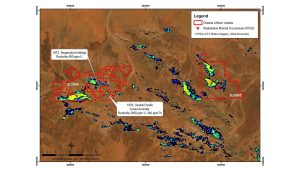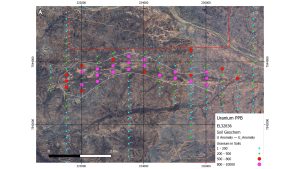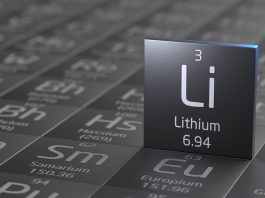Oceana Lithium is advancing both the Solonópole Lithium Project in Brazil and the Napperby Project in Australia.
Asx-listed Oceana Lithium updated the market last month about a large uranium anomaly at its 100% owned Napperby Project in the Northern Territory.
The results of recent soil sampling defined a uranium anomaly more than 4.5km in length and up to 700m in width. Re-examination of hyperspectral data by HyVista Pty Ltd supports ‘roll-front’ style uranium mineralisation interpretation for the anomaly.
The Company is also advancing its Solonópole Lithium Project in Ceara State, Brazil, after announcing positive results from the project’s first systematic exploration campaign.
Large uranium anomaly identified at the Napperby Project
The 1,160km2 Napperby Project is located within the highly prospective Arunta Province, which is endowed with some of the most prospective rocks for lithium (Li), rare earth elements (REEs) and uranium (U) mineralisation in the Northern Territory.
The Paleoproterozoic Wangala and Ennugan Mountains granites have long been recognised as ‘hot granites’ and are known to be anomalously enriched in a range of elements, including U, thorium and REEs.

Both granite plutons show outstanding uranium/thorium ratios and are almost fully encapsulated within Oceana’s Napperby Project leases EL32836 and ELA32841 (under application), as shown in Fig. 1 above.
A soil geochemistry infill sampling programme was completed during the December quarter of 2023 in the southeast corner of EL32836 to better define and understand the lithium anomalies highlighted by the 2022 soil sampling programme (refer to ASX Announcement dated 28 November 2022).
A total of 107 samples were collected at 200m spacings for approximately 30 line-km, infilling the previous 2km line spacing to 500m. Although initially targeting lithium, the results from the soil sampling have defined a large arcuate uranium anomaly, as shown in Fig. 2.
Oceana further updated the market on 15 May 2024, citing historical information from Callabonna Uranium Ltd (Callabonna) between 2009 and 2013, further enhancing uranium prospectivity at Napperby.

Shallow diamond drilling completed by Callabonna revealed secondary enrichment of uranium with a peak of 1170 ppm U. Callabonna completed a shallow three-hole diamond drill programme on a granite exposure previously named the Platform Prospect. These holes were designed to target anomalous uranium values (100 to 1000 ppm U) ascertained from 35 rock chip assays and ground radiometric (collected using a handheld gamma-ray spectrometer) to determine if higher-grade uranium mineralisation occurred at depth or was restricted to the surface weathering profile.
Oceana’s CEO Caue (Paul) Araujo commented: “The historical information from Callabonna has not only boosted the uranium prospectivity of Napperby but has also provided strategic information for the optimisation of our field activities in June 2024. We look forward to firming up targets for drilling as soon as practicable.”
Oceana’s advantageous Solonópole Lithium Project
In Brazil, Oceana has an early mover advantage, having picked up its Solonópole Project prior to 2023 when the country emerged as a lithium exploration hotspot. It now has advanced drill-ready targets and several soil anomalies identified throughout the project area.
Since its inception in July 2022, the Company has quickly built a strong in-country team, allowing Oceana to simultaneously develop the Solonópole Project and assess new opportunities in the Brazil and other South American countries.
Oceana’s systematic exploration approach at Solonópole includes over 10,365 soil samples analysed by XRF for Lithium-Caesium-Tantalum (LCT) pathfinders, of which 2,323 soil samples have also been analysed by SGS laboratory. Anomalous lithium values above 100 ppm and up to 631 ppm were found in 383 soil samples within existing and new target areas.
Together with the new data from geophysics, these soil geochemistry anomalies have indicated several swarms of pegmatite bodies striking in a NE-SW and E-W directions. This new information is significant, showing that there is more than one lithium bearing pegmatite at the Bom Jesus de Baixo (BJdB) prospect.
Shallow scout drilling completed in June 2023 with anomalous lithium grades (up to 0.95% Li2O) and tantalum grades (up to 380 ppm) returned from seven drill holes (NGR-RC-002, NGR-RC-009, NGR-RC-014, SOL-RC-001, SOL-RC-002, SOL-RC-005 and SOL-RC-008) confirming their Lithium-Caesium-Tantalum (LCT) pegmatite nature.
To date, over 138 km of geological mapping has been completed, including detailed geological and structural mapping of high-priority targets.
In sum, the results of the scout drilling programme and the anomalous lithium grades intercepted suggest that the mineralisation observed at the surface continues at depth. Oceana’s follow-up drilling campaign will not only help confirm the exact extension of this lithium mineralisation at the BJdB targets but also test other new pegmatites identified at other locations within the various Li-anomalous soil grids.
Oceana continues to assess other potential opportunities in Brazil and South America, where the exploration sector is quickly emerging as a hot spot for critical minerals and renewable energy.









